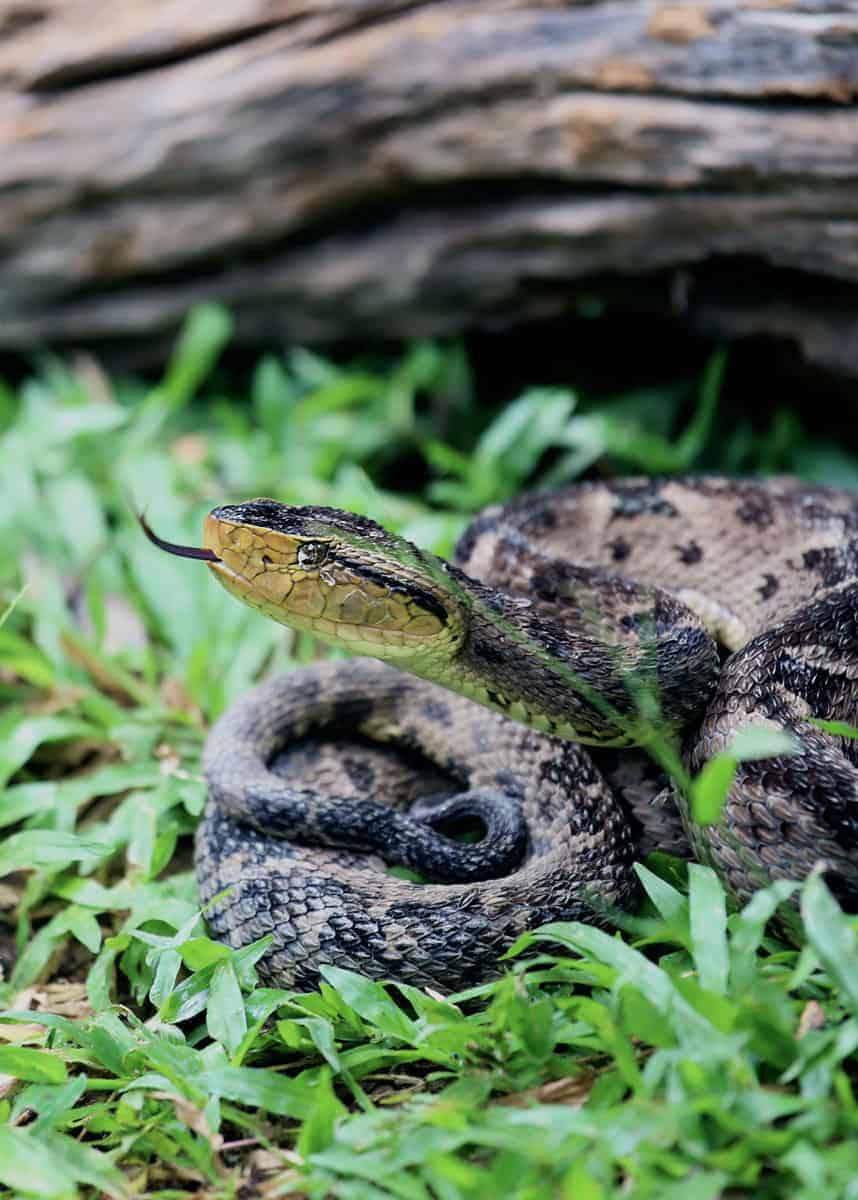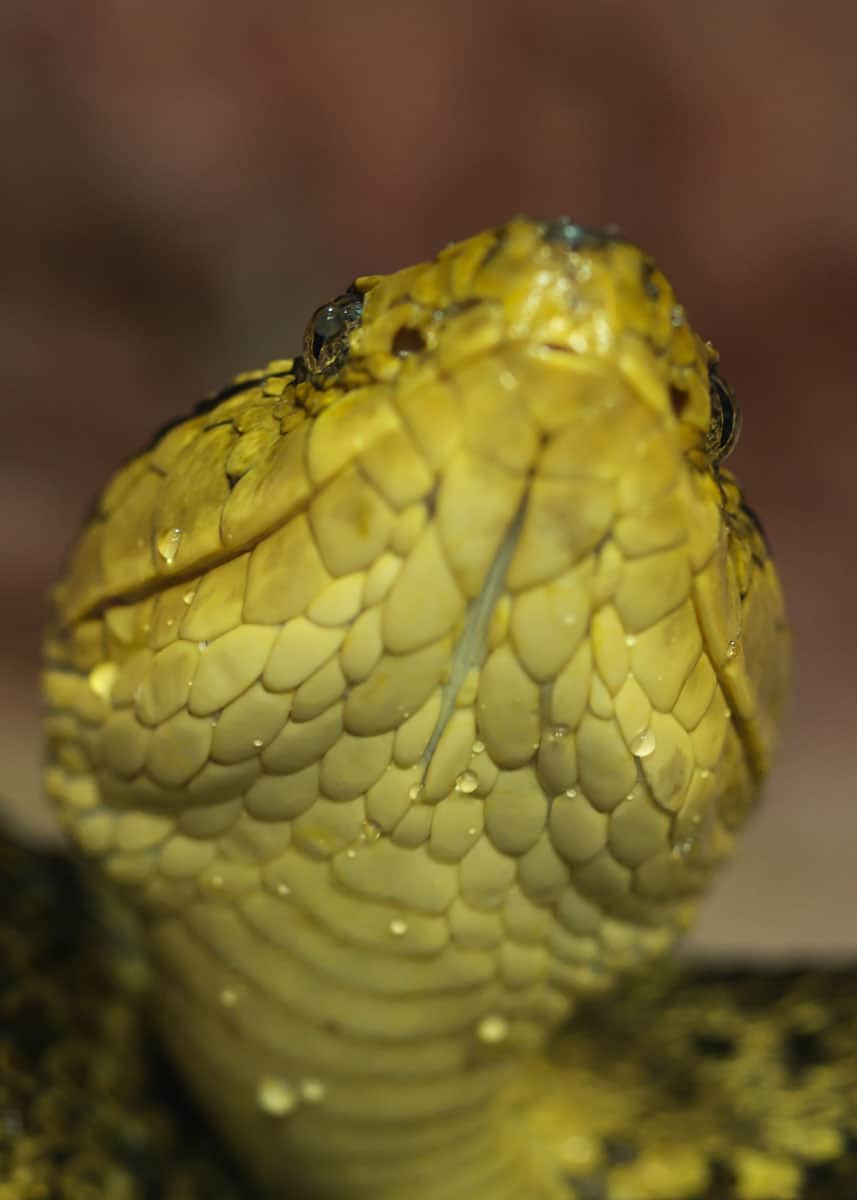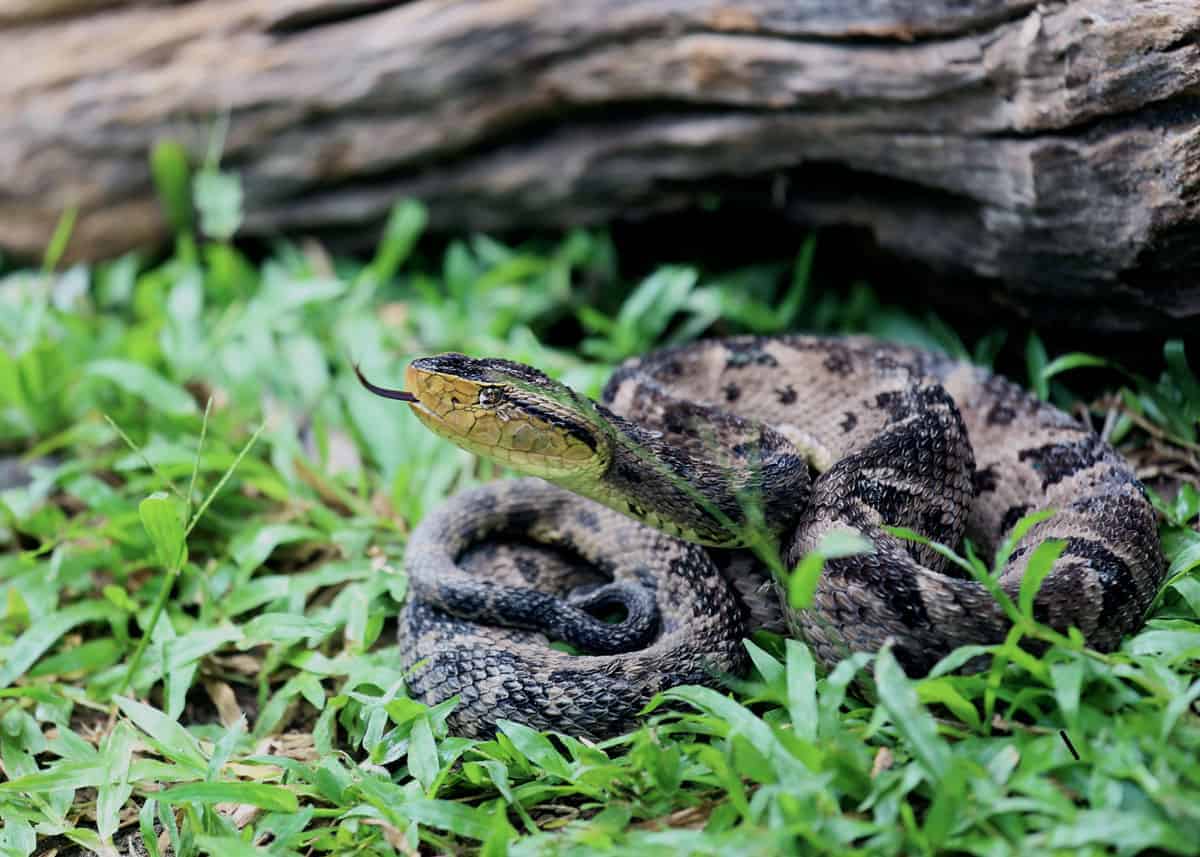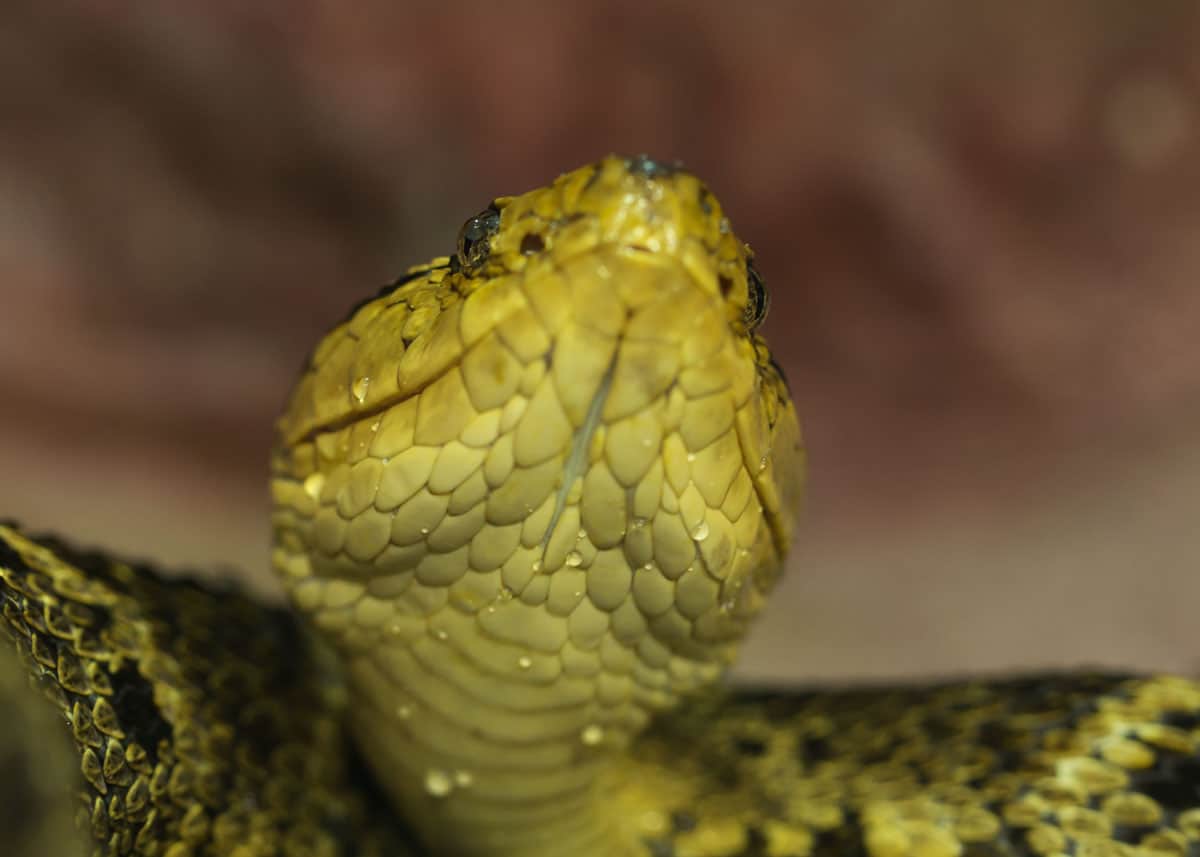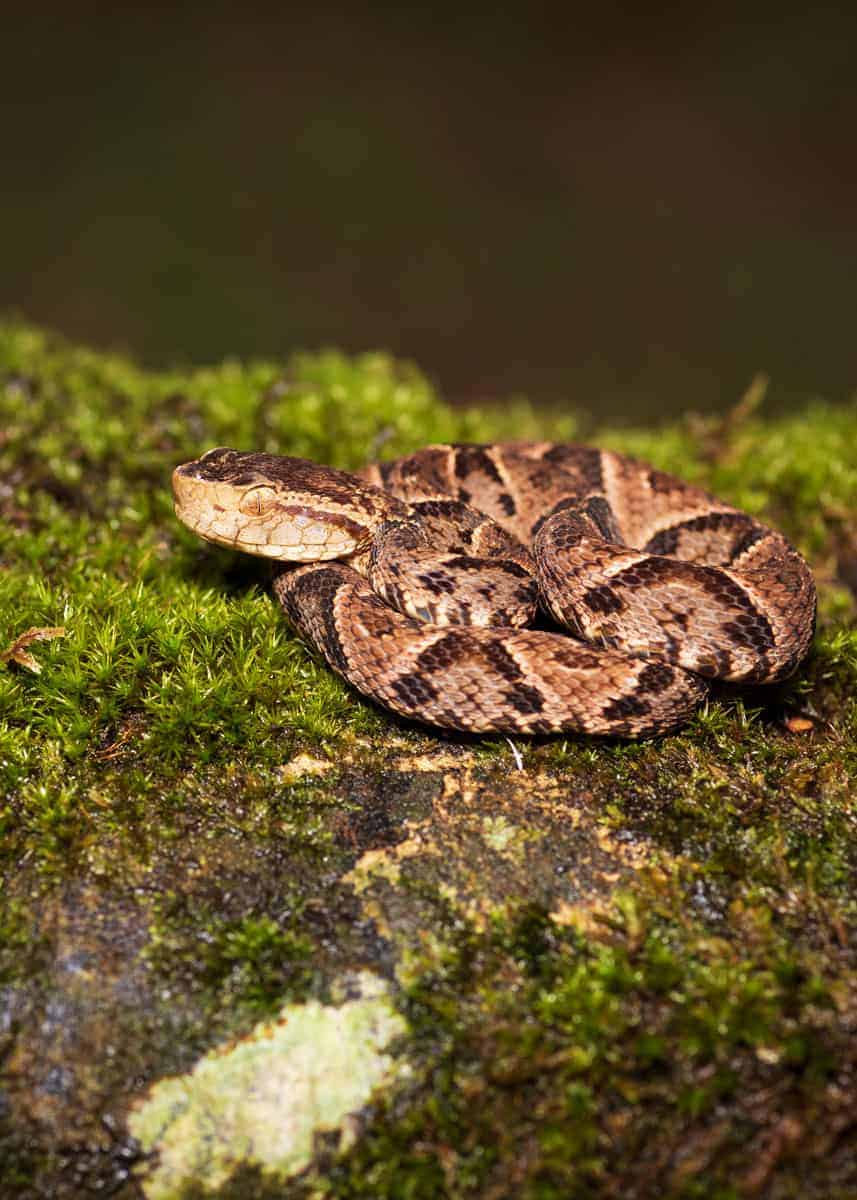40 Bothrops Asper Facts: Guide to Fer de Lance (Terciopelo Viper)
The bothrops asper is one of the most dangerous snakes in the Americas. In this post, you’ll learn about these short-tempered and highly poisonous fer de lance, terciopelo vipers. We’ll cover their diet, size, habits, differences, and more. Plus, their unusual hunting method, heat-sensing abilities, and reproduction.
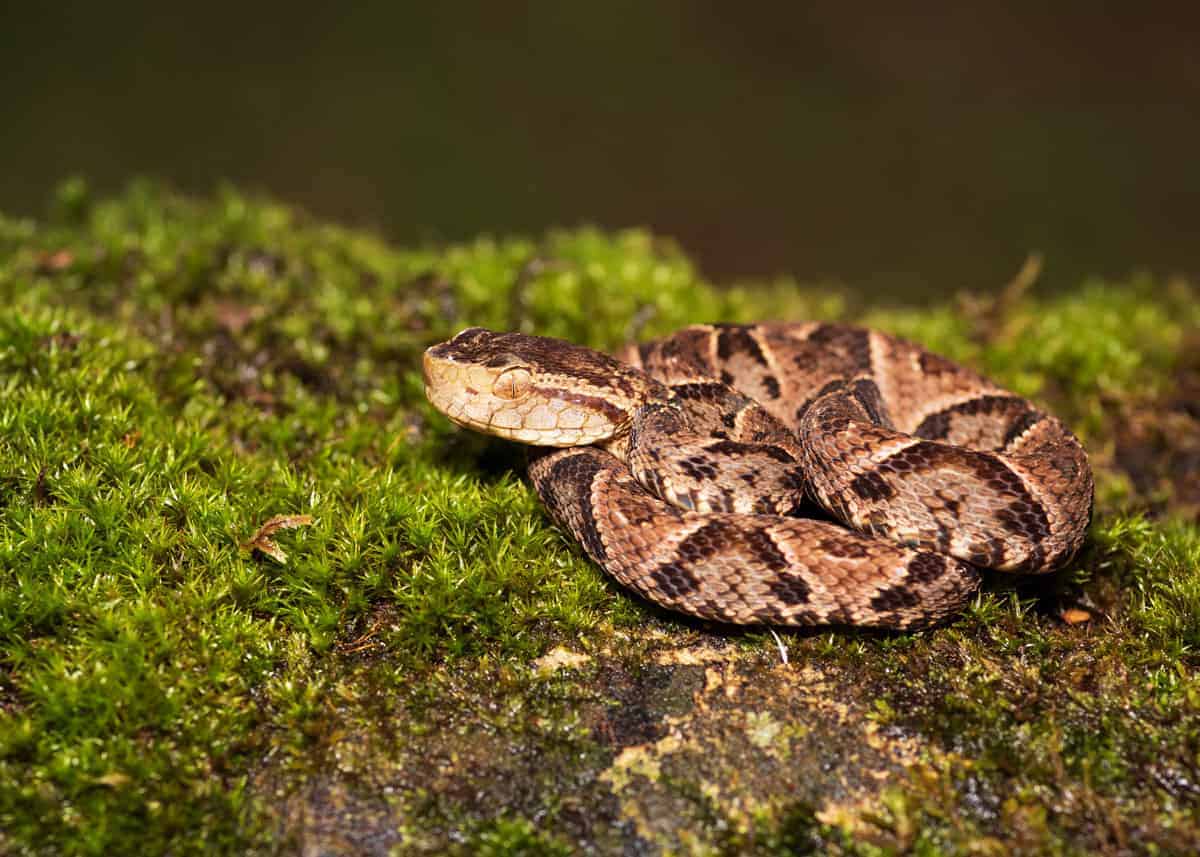
Travel tip: If you’re snake spotting, you should bring a camera with a good zoom and a decent pair of binoculars. This will increase the odds of safely spotting and shooting the terciopelo in the wild.
Bothrops Asper Overview
- Latin name: Bothrops asper
- Range: South and Central America (Mexico, Ecuador, Guatemala, Honduras, Venezuela, Trinidad, Nicaragua, Costa Rica, Ecuador, Panama)
- Population Status: Stable
- Length: 4 – 6 feet
- Weight: 10 – 13 pounds
- Diet: Rodents, possums, lizards, frogs, birds, insects
- Physical features: Big bodies, triangular markings, death-dealing fangs
- Where it lives in Ecuador: Rain forests, lowlands, agricultural areas
40 Bothrops Asper Facts
1. What is a Bothrops asper?
The Bothrops asper is a highly venomous snake that’s native to South and Central America.
It’s big, strong and easily provoked, and since it often lives in close proximity to human settlements, it’s responsible for countless snake bites each year.
2. What does the Bothrops asper look like?
You’ll definitely see this snake before you step on it. It can be longer than a human from tip to tail, and despite its deceptively slim body, it weighs as much as a bowling ball or a hefty sack of potatoes.
The most distinctive feature of the bothrops asper is its head. It has a broad, flat skull that sticks out from its body, and two flickering eyelids are set on either side of the snout. A few inches down, heat-sensing pit organs flare from the nose. Pointed fangs can give you a fright when they open their mouth.
As for their coloring, bothrops aspers are dark brown with various markings in black, beige, tan, yellow, cream and olive. These markings are usually triangular, but they can become more striped or mottled depending on the region and its particular snakes.
They might have a yellow neck or belly that earns them the nickname “yellow jaw” or “yellow beard.”
3. Are female bothrops aspers bigger than males?
Yes. In fact, they have one of the highest sexual dimorphism rates in South American vipers.
It starts when they’re adolescents. Bothrops aspers are all the same size when they hatch, but between 7 – 12 months, the females start overtaking the males and becoming much bigger and heavier.
Adult males do have one advantage over adult females. They have brightly-colored scales on their tail tips that help them lure in prey. For some reason, females never have these specific splashes of color.
4. How big is a bothrops asper?
Bothrops aspers range between 4 – 6 feet when fully grown.
Females are larger than males, and the occasional giantess can reach a length of 7 – 8 feet, but this is rare. They usually weigh around 10 – 13 pounds.
5. Is the bothrops asper a pit viper?
Yes. Pit vipers get their name from the heat-seeking organs that they have in the “pit” of their face.
These organs basically work like infrared sensors that can detect warmth and motion. When a bothrops asper feels a disturbance in the force, they strike.
6. How did the bothrops asper get its name?
Bothrops asper is a combination of Greek and Latin:
- The Greek is bothros (pit) and ops (face), which refers to their nature as pit vipers.
- The Latin is asper or “rough/harsh” and refers to snake scales.
7. Are there any subspecies of bothros aspers?
The bothrops asper doesn’t have any subspecies, but it’s part of a large family of snakes known as “Bothrops.”
These include Bothrops atrox and Bothrops jararaca, two species with dark colors and triangle patterns that are commonly confused for Bothrops asper.
There are 45 species of bothrops in total.
8. What are common names of the bothrops asper?
Bothrops asper is the scientific name of the species, but it goes by many different names in other countries and languages.
Here are some of the common names of the bothrops asper.
- Terciopelo (Spanish, “velvet”)
- Fer-de-lance (French, “spearhead”)
- Nauyaca (Mexican dialect, “four noses”)
- Mapepire balsain (Trinidad)
- Carpet Labaria (Guyana)
- Barba amarilla (Guatemala, Honduras, “yellow beard”)
- Equis (Ecuador and Panama, “x”)
- Taya equis (Colombia)
- Cuaima (Venezuela)
- Yellow-jaw tommygoff (Belize)
9. What does fer de lance mean?
Fer de lance is French for “lancehead” or “spearhead.” It refers to the angular lines of the Bothrops asper snout.
10. What does terciopelo mean?
Terciopelo is Spanish for “velvet.”
Interestingly, even though the word asper translates to “rough,” Bothrops aspers are known for having a smooth and velvety feel.
11. Is fer de lance and bothrops aspers the same snake?
They can be. Fer de lance is sometimes used for other species in the Bothrops family, and so is terciopelo and the general term “Bothrops.”
To avoid confusion, always look at the scientific name of the species that you’re researching.
All Bothrops aspers are fer de lances, but not all fer de lances are bothrops aspers.
12. What is the Bothrops aspers Latin name?
The scientific name of the bothrops asper is literally Bothrops asper. As for its family tree, here’s how it all breaks down:
- Class: Reptilia (reptiles)
- Order: Squamata (lizards and snakes)
- Family: Serpentes (snakes)
- Subfamily: Viperidae (vipers)
- Genus: Bothrops (specific type of pit viper)
- Species: Bothrops asper
13. Where does the Bothrops asper live?
The Bothrops asper is widespread across Central and South America, but here are a few of its biggest regions and habitats:
- In Ecuador, they’re found in both wet and dry forests. The most sizeable population is in the Amazon rainforest area, but they’re also scattered along the coasts and lowlands of open clearings.
- In Mexico, they inhabit “cloud forests” with high levels of mist and rainfall.
- In Costa Rica, they live near banana plantations, cacao fields and other agricultural areas.
- In Venezuela, they like the high cliffs and rocks of the mountains. These vipers live at the highest elevations of any Bothrops aspers.
14. Do Bothrops aspers have fangs?
Yes. Bothrops aspers have sharp and highly venomous fangs, and they don’t have to be biting your flesh to do some damage.
15. Is the Bothrops asper nocturnal?
Yes. This species sleeps during the day and hunts at night. Since they use their infrared senses to detect their prey, they don’t need light.
16. Is Bothrops asper poisonous?
No. Bothrops aspers are venomous, not poisonous. There’s a difference between venomous and poisonous:
- Venomous means that the creature’s toxins are injected through a bite.
- Poisonous means that the plant or animal carries its toxins internally. They don’t necessarily bite, but they can be dangerous if you touch or eat them and absorb their poison into your bloodstream.
Bothrops aspers are venomous. They use their fangs to deliver fast-acting venom that can cause everything from uncontrollable bleeding to fatal organ failure. It’s horrifying, but it’s not poisonous. It’s venomous.
17. Are Bothrops aspers aggressive?
If you’ve been paying attention, you know that Bothrops aspers are highly dangerous snakes with sizzling bites that result in a lot of pain and suffering for their victims. However, the species isn’t as aggressive as you might think.
Bothrops aspers are secretive and solitary. They live their own lives and mind their own business, and they aren’t particularly hostile in anything but their hunting habits.
Their bites are mostly the result of defensive reactions. They don’t like being threatened, disturbed or agitated, and they’ll lash out if they think that something poses a risk to them.
They can be quite unpredictable in their movements, too. A defensive Bothrops asper might strike, flee, change its mind, turn back around and strike some more. They might chase you out of their territory in an aggressive display of dominance, or they might retreat far away from you in a scared flight. It all depends on the individual snake.
18. Can a Bothrops asper kill a human?
Yes. In fact, they’re quite good at it. The fatality rate for Bothrops asper bites is somewhere between 6 – 9 percent.
It’s hard to pin down a specific number since they’re found in so many countries with so many independent death and hospitalization rates.
This is especially true in rural areas where the bite victims don’t have access to modern medical care. Even if they make it to a doctor after the symptoms have started, it might be too late to save them.
19. What are the symptoms of a Bothrops asper snake bite?
The bite of a Bothrops asper is extremely unpleasant. Not only does it cause excruciating pain, but it’s also prone to bruising, swelling, oozing and blistering. It can cause symptoms such as fever, nausea, weakness, dizziness, coughing up blood, impaired mental state and bleeding from the face and gums.
Some people bitten by a Bothrops asper go into hemorrhagic shock from losing so much blood. Others experience necrosis in the limbs where they were bitten, and it causes a spreading gangrene infection that eventually requires amputation.
In fatal cases, death is usually caused by shock, sepsis, hemorrhage or organ failure.
20. How much poison does a fer de lance have?
The Bothrops asper delivers around 260 milligrams of venom per bite, and that’s just an average. The most potent bites hold around 800 milligrams of venom!
Have you heard of snake-milking? This might make you wonder: Do snakes nurse their young?
21. Is fer de lance the most poisonous snake?
Despite the agony inflicted by its bite, the Bothrops asper isn’t the most venomous snake in the world.
That honor is usually bestowed on the inland taipan, an Australian snake that can cause death in less than an hour after a bite. Its venom is so potent that a single dose could kill 100 humans (or 250,000 mice)!
Other dangerous snakes include:
- Black mamba
- Tiger snake
- Rattlesnake
- Philippine cobra
- Blue krait
There’s also the death adder, a snake that delivers a bite with “only” 40 – 100 milligrams of venom, but it compensates by having one of the quickest striking rates in the world. It can bite you once every 0.13 seconds.
22. Where are the deadliest regions for Bothrops asper snake bites?
We don’t have statistics for every single country where Bothrops aspers are found, but the data that’s available to us is quite alarming:
- In Argentina, the Bothrops asper is responsible for 97 percent of all snake bites.
- In Columbia, they make up 50 – 70 percent of all snake bites. Nine percent of these cases have permanent side effects such as amputation or organ damage, and six percent result in death.
- In Costa Rica, they’re responsible for 46 percent of all snake bites and 30 percent of all hospitalizations caused by snake bites.
- In the Venezuelan state of Lara, they’re responsible for all snake bite fatalities.
23. Why are Bothrops aspers so dangerous?
While their venom is potent, their danger has more to do with their habitat and personality. They typically live in the same areas as humans. And they are highly defensive.
This means that humans are more likely to meet this species. And when they do, the fer de lance is quick to bite. According to “Snake Species of the World: A Taxonomic and Geographic Reference, vol. 1. Herpetologists’ League” (511 pp.) this has resulted in this species being the main cause of snakebite incidents in its range.
24. Are there any good reasons to keep Bothrops aspers around?
You might be wondering why people in South America tolerate the bothrops asper at all. Why don’t they shoot these deadly vipers on sight?
For starters, the Bothrops asper can have a positive ecological impact on their environment. Since they feed on rodents and insects, they can be used for pest control in agricultural areas. They can also serve as the prey for valued bird species that people want to attract to their region.
There’s even evidence that bothrops aspers served as “border protectors” when ancient South American civilizations made their settlements. They built their villages behind snake-infested forests, and their enemies couldn’t or didn’t want to cross such dangerous territory.
25. How long do Bothrops aspers live?
No one is sure about their lifespan because they’re so difficult to track and capture in the wild, but it’s assumed that Bothrops aspers live around 15 – 21 years. That’s their lifespan in captivity, anyway.
26. What eats a Bothrops asper? Predators and Threats
They’re terrifying creatures, but believe it or not, the Bothrops asper is preyed on by quite a few predators.
Their biggest enemy is the laughing falcon. Also known as “snake hawks,” these large, fast-moving birds can incapacitate a snake in one dramatic swoop from above. They bite behind the head and sometimes tear it clean off.
Another enemy is the mussurana. These cannibalistic snakes use their own coils and fangs to prey on their kind. They don’t even have to worry about bites; their blood has special properties that inhibit the toxins of the asper’s venom.
Other predators of the Bothrops asper include raptors, crane hawks and swallow-tail kites. On the ground, skunks and raccoons can pounce on juveniles that haven’t grown to their full size. Babies are vulnerable to spiders, lizards, rodents and crabs.
27. Bothrops asper vs goliath tarantula
It sounds like something out of a movie: killer snake versus hairy spider. Who wins the fight?
The short answer is “it depends.” While it’s not uncommon for tarantulas to prey on young, defenseless snakes, you don’t often see fully-grown adults duking it out. It’s a rare and gruesome sight.
That said, it does happen:
The tarantula was the winner of this fight. There are also reports of tarantulas killing other viper breeds, so they might have an edge when it comes to real-world combat.
However, there hasn’t been enough research and observation to definitively say that spiders are the stronger species. For all we know, the Bothrops asper is out there kicking butt and taking names whenever a tarantula crosses its path!
28. How do Bothrops aspers protect themselves?
It’s always a coin toss when you’re dealing with the fight-or-flight response of the bothrops asper.
On one hand, they’re a secretive species that likes to hide in foliage and wait for prey, and they’ve also been known to flee from danger when threatened or frightened. They’re definitely a defensive species rather than an aggressive one.
On the other hand, bothrops aspers can put up a fight. They have sharp fangs that can shoot venom from several feet away, and they aren’t afraid to lash out over and over with angry strikes that end in painful bites.
29. Is the Bothrops asper endangered?
The bothrops asper hasn’t been evaluated by conservation groups, so we don’t know their exact population status.
However, it’s been suggested that they might be a “least concern” on the extinction scale because of their wide, diverse range and thriving native populations.
30. What do Bothrops aspers eat?
Bothrops aspers will eat anything that doesn’t eat them first.
They’re carnivores that enjoy rats, rabbits, possums, lizards, frogs, birds and insects. For aspers that live on the coast, they’ll occasionally go into the water and catch crayfish.
31. How do Bothrops aspers hunt? (Caudal luring)
These snakes are ambush predators. They don’t mind chasing down a meal if it tries to flee, but they don’t actively “stalk” their prey. Instead, they slither into a good hiding spot under a leaf or bush and wait for their victims to come to them. Their infrared sensors let them know when dinner is ready.
Bothrops aspers also engage in something called caudal luring or aggressive mimicry. This is when they disguise themselves as prey animals to lure in their real prey. They’ll hide their bodies under a log or behind a rock while curling their long, spindly tail in plain sight, and other animals will mistake it for a worm or rat.
By the time that they’ve realized their mistake, it’s too late.
32. Do Bothrops aspers lay eggs?
No. Bothrops aspers give birth to live young, which is somewhat rare for a snake species. It’s called viviparity and is also seen in the emerald tree boa.
33. What does the reproductive process look like for Bothrops aspers?
All bothrops aspers reproduce in the same way, but they have different schedules and habits depending on their region.
On the west side, the one near the Pacific Ocean, the snakes mate between September – November and give birth between April – June. The average litter can be anywhere from 5 – 40 babies. They’re relatively small for such a big species; they measure between 11 – 14 inches and weigh around 0.24 – 0.46 ounces.
Over on the east side with the Atlantic ocean, Bothrops aspers mate in March and have their babies between September – November. They’re giving birth when the other region is just getting started. Their offspring is also bigger and more numerous: The litters have anywhere from 14 – 86 offspring at a time, and the babies are a whopping 10 – 14 inches and 0.22 – 0.71 ounces.
The gestation period is 6 – 8 months for both regions. It also seems to be a universal truth that bigger females produce bigger litters.
34. Do Bothrops aspers mate for life?
No. Females will mate with multiple males during their fertile periods, and the male’s contribution to the family stops there. Dad doesn’t help mom with any part of the pregnancy or birth.
35. Do Bothrops aspers carry disease?
It isn’t known if Bothrops aspers carry any specific diseases. However, they’re highly venomous, and people have gotten infections from the bacteria of their bites.
They also have a lot of internal parasites, so it’s possible that these microorganisms can cause human illnesses. They might carry and transmit the hepatitis virus, but the research is inconclusive.
36. What is the habitat of the Bothrops asper?
Rainforests are the preferred habitats of Bothrops aspers. They like the heat, humidity and leaf coverage as they hide in the bushes and look for prey using their highly sensitive nose organs.
They can live in many different environments, however. They’ve been found in deserts, lowlands, dry forests, wet forests and savannas. They also have the habit of moving into recently-cleared agricultural lands, which is one of the reasons why they’re so dangerous to humans. Their proximity results in a lot of bites.
37. What layer of the rainforest does the Bothrops asper live in?
Bothrops aspers are usually terrestrial; that is to say, they live on the ground. Juvenile snakes will sometimes play or hunt in trees, but it’s not an everyday occurrence.
Fun fact: Despite their preference for the ground, Bothrops aspers are sometimes known as “high-dwelling” snakes. This is because some groups live in the various mountain regions of South America. They’ve been found at altitudes as high as 8,660 feet above sea level!
Here’s their general range:
- 3,900 – 4,300 feet in the southern regions of North America (Mexico, Honduras)
- 7,200 – 8,660 feet in the northern regions of South America (Nicaragua, Venezuela, Ecuador)
38. How can I protect myself against a Bothrops asper?
If you see a bothrops asper in real life, your best bet is to turn around and take another trail. While they aren’t inherently aggressive, they can have knee-jerk reactions to perceived threats, and it’s very difficult to know what might set them off.
They might let you walk past them. They might decide that you’re a big stomping predator that needs to be taken down. The reality is that you likely will walk past many and not even know that they’re there.
According to Michael Lovatt, who was bitten while walking along a beach at night in the city of Quepos, Costa Rica, he didn’t even see it before he was bit. ”
“All of a sudden there’s this intense pain on my foot. By the time I [shone] my flashlight down on [my foot], I just see three red dots and it’s sore… It went downhill real quick right after,” he said.” via CBC.ca
If you see one, do yourself a favor and just turn around. It’s always better to be safe than sorry.
39. What do I do if I’ve been bitten by a Bothrops asper?
If you’ve felt the sting of the Bothrops asper fangs, seek medical attention immediately. Don’t wait for symptoms to start!
Necrosis can take over an arm or leg in a matter of days, and in many cases, amputation is the only way to stop it from spreading further.
You’ll also need to be treated for infections, viruses and other nasty things that can be transmitted through a wild snake bite. The doctor will probably need to give you multiple rounds of anti-venom and antibiotics.
40. Where can I see the Bothrops asper?
In addition to in the wild, you can the Bothrops asper in some zoos. From my research, it’s only found in certain zoos and wildlife centers. And this can change. Both the Cincinnati Zoo and the Belize Zoo have the fer de lance listed, but it’s unclear if they currently have one on display.
Check your local zoo to see if they have a bothrops asper.
More reading: Guide to Ecuador’s Amazon Rainforest Animals
Defiant and Deadly: The Bothrops Asper
We hope that you enjoy these facts about the bothrops asper. From their laser-guided noses to their jaw-dropping bites, they’re some of the most fascinating snakes in the world, and they deserve more love. Just make sure that you love them from a safe distance.
Have a question or fact to share? Join me below!

